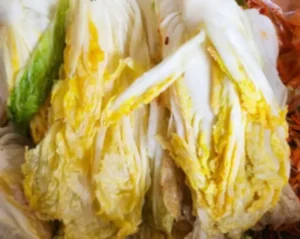What is Kimchi?
Kimchi is a traditional Korean dish known for its unique fermentation process and bold flavors. It’s not just a side dish; it’s a staple of Korean cuisine, rich in probiotics and nutrients. With a history stretching back over a thousand years, kimchi has evolved into various types, each with its distinctive taste and texture. Let’s dive into the different types of kimchi and how to make them at home.
Types of Kimchi
1. Baechu Kimchi (Napa Cabbage Kimchi)
The most popular and widely consumed type of kimchi is Baechu Kimchi. Made from napa cabbage, this version combines spicy, salty, and umami flavors. The cabbage is fermented with a paste made from gochugaru (Korean chili flakes), garlic, ginger, and fish sauce. The result is a crunchy, flavorful kimchi that complements almost any Korean meal.

2. Kkakdugi (Radish Kimchi)
Kkakdugi is made using cubed Korean radishes, also known as mu. This type of kimchi has a refreshing crunch and a sharp flavor. The radish is mixed with a spicy paste similar to the one used in Baechu Kimchi, resulting in a vibrant dish that’s perfect with soups and stews.
3. Baek Kimchi (White Kimchi)
For those who prefer milder flavors, Baek Kimchi is an excellent option. Unlike other kimchis, it is made without chili flakes, giving it a clear, clean taste. Baek Kimchi is fermented with ginger, garlic, and pears, producing a subtle, slightly sweet flavor. It’s an ideal choice for those who can’t handle too much spice.
4. Pa Kimchi (Green Onion Kimchi)
Pa Kimchi is made from green onions, offering a sharp and slightly spicy taste. It’s one of the quickest types of kimchi to make, as it requires less preparation time. The green onions are coated with a spicy seasoning paste, and after a few days of fermentation, they develop a rich, bold flavor.
5. Yeolmu Kimchi (Young Radish Kimchi)
Yeolmu Kimchi is made from young radish greens and is often eaten in the summer. This kimchi is less spicy and has a fresher, more vegetal flavor. It’s typically served with cold noodles or as a side dish to balance out heavier meals.
How to Make Kimchi at Home
1. Ingredients You’ll Need
To make traditional kimchi, you’ll need the following ingredients:
- Napa cabbage (or radish for Kkakdugi)
- Salt (for brining)
- Gochugaru (Korean chili flakes)
- Garlic and ginger
- Fish sauce or salted shrimp
- Sugar (optional for sweetness)
2. Preparing the Cabbage
Start by salting the cabbage to remove excess moisture. Cut the cabbage into halves or quarters and soak it in saltwater for 2–3 hours. This process softens the cabbage and prepares it for fermentation. For Kkakdugi, cube the radish and follow a similar salting process.
3. Making the Kimchi Paste
Create a paste using gochugaru, minced garlic, grated ginger, fish sauce, and a bit of sugar if desired. The paste should be well-mixed and thick enough to coat the cabbage leaves thoroughly. Adjust the spice level according to your preference.
4. Mixing and Fermenting
Once the cabbage is ready, rinse it well to remove excess salt. Spread the paste evenly between the cabbage leaves, ensuring each layer is coated. Place the coated cabbage into an airtight container and leave it at room temperature for 1–2 days for initial fermentation.
5. Storing the Kimchi
After the initial fermentation, store the kimchi in the refrigerator to slow down the fermentation process. Kimchi will continue to develop flavors over time, and it can be enjoyed fresh or aged for a more sour, tangy taste.

Health Benefits of Kimchi
Kimchi is more than just a delicious side dish. It is packed with probiotics that promote gut health and aid digestion. Additionally, it is rich in vitamins A, B, and C, and antioxidants. The fermentation process enhances these nutrients, making kimchi an excellent addition to a balanced diet.
Conclusion
Kimchi is a versatile and nutrient-rich dish with endless variations to explore. Whether you enjoy the spicy kick of Baechu Kimchi or the milder flavors of Baek Kimchi, there’s a type of kimchi for everyone. With simple ingredients and a little patience, you can easily make kimchi at home and enjoy its health benefits.